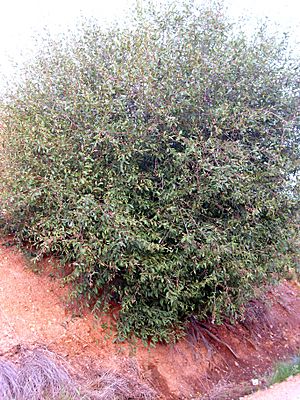Salix pedicellata facts for kids
Salix pedicellata is a type of willow plant. It can grow as a bush or a small tree, reaching about 6 to 8 meters (20 to 26 feet) tall. You can find it naturally around the Mediterranean Sea. This includes countries like Portugal, Lebanon, Syria, the Canary Islands, and Tunisia. Sometimes, another willow called Salix canariensis is considered a close relative or a special type of S. pedicellata.
Quick facts for kids Salix pedicellata |
|
|---|---|
 |
|
| Conservation status | |
| Scientific classification | |
| Synonyms | |
|
Contents
What it Looks Like
Salix pedicellata can look quite different from one plant to another. It usually grows as a bush or a small tree, up to 6 to 8 meters tall. Its main stem, or trunk, can be up to 1.4 meters (about 4.5 feet) wide, but it's often smaller.
Twigs and Leaves
The young branches, called twigs, are dark brown. When they first grow, they have short, soft hairs. As they get older, they become smooth. If you peel the bark off a twig, you might see clear lines or ridges running along it.
The leaves are usually long and oval-shaped. They are about 4 to 16 centimeters (1.5 to 6 inches) long and 1 to 5 centimeters (0.4 to 2 inches) wide. The top side of the leaf is green, while the bottom side is grayish. You can see the veins clearly on the underside.
Flowers and Seeds
Salix pedicellata flowers in early spring, usually from February to April in its natural home. Its flowers grow in clusters called catkins.
- Male catkins are usually packed tightly with flowers and are 2 to 4 centimeters (0.8 to 1.6 inches) long.
- Female catkins are less dense, meaning you can often see the stem they grow on. They are a bit longer, about 5 to 8 centimeters (2 to 3 inches) long.
Both male and female flowers have a single nectary, which produces a sweet liquid to attract insects. The seeds are small, about 1.25 millimeters long and 0.5 millimeters wide. They are black to olive green in color and shaped like tiny cylinders.
Plant Family and Naming
Salix pedicellata was first described by a scientist named René Louiche Desfontaines in 1799.
Sometimes, another type of willow, Salix canariensis, is considered a special kind of S. pedicellata. When this happens, S. canariensis is called S. pedicellata subspecies canariensis. The original S. pedicellata then becomes S. pedicellata subspecies pedicellata. Think of a subspecies as a distinct group within a species.
This willow can also mix with another willow species called Salix atrocinerea to form new types of plants.
Where it Grows
Salix pedicellata subspecies pedicellata is found naturally in several countries around the Mediterranean Sea.
- In Europe: Portugal, Spain, Sicily, mainland Greece, and Crete. It might also be in mainland Italy, but this is less certain.
- In North Africa: Morocco, Algeria, and Tunisia.
- In Western Asia: The East Aegean Islands, Turkey, and the area of Lebanon and Syria.
It has also been brought to Ethiopia by people.
The subspecies Salix pedicellata subspecies canariensis is native to Madeira and the Canary Islands.
See also
 In Spanish: Bimi para niños
In Spanish: Bimi para niños


